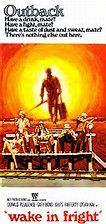Donald
(Demon Seed) Cammell’s White of the Eye is a moody, experimental, and intriguing
little serial killer thriller. It also
happens to be uneven, muddled, and frustrating as Hell. One thing is for sure, only someone with a
knack for anything-goes dreamlike madness like Cammell could’ve concocted it.
David
Keith is a stereo installer in Tucson who has an odd gift for knowing exactly
where to place speakers just by closing his eyes. Even though he’s married to the luscious Cathy
Moriarty, he still happens to mess around with his lonely, sexy clients. When one of them winds up murdered by a
serial killer, it makes Keith the prime suspect.
The
big problem with White of the Eyes is its languid pacing. Clocking in at almost two hours, it really drags
in the middle and some of Cammell’s cinematic indulgences (like the extreme
eyeball close-ups) can be grating at times.
Now that I’ve gotten that off my chest, there are some sterling stalking
sequences here, along with a handful of truly bizarre images that help to
separate the film from dozens of similarly-themed thrillers.
The
story itself is one-note and predictable.
Had it been lacking Cammell’s stylish flair, White of the Eye would have
been instantly forgettable (save for some of Keith’s intense theatrics). Cammell gives the murder set pieces a stylized
kick. The scene where the killer puts a
woman in a pile driver like a wrestler is just so bonkers that it works. Other sequences feel like they came out of an
Italian giallo.
So,
in the end, it’s a toss-up. Come for the
stylish murders, random weirdness, and Keith’s overacting. If you can get past the boring flashbacks,
Indian mumbo jumbo, and general lackadaisical pace, you just might like it.






